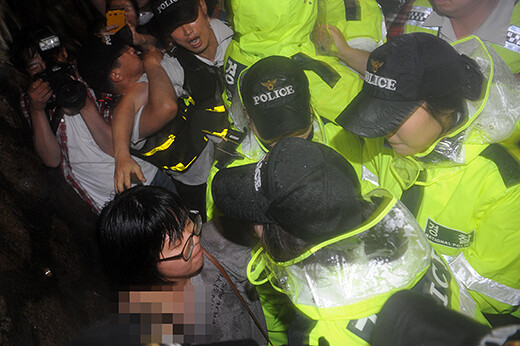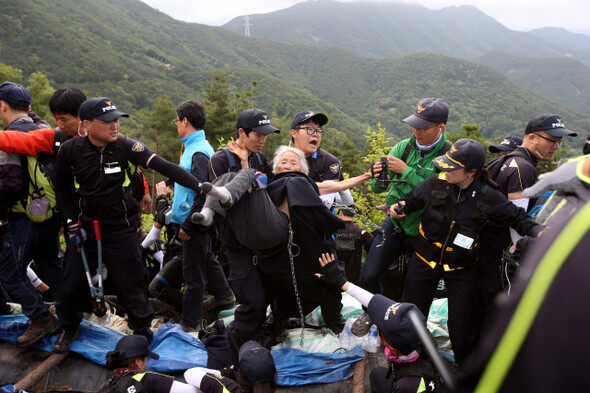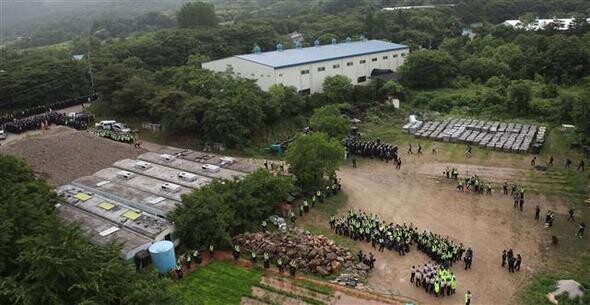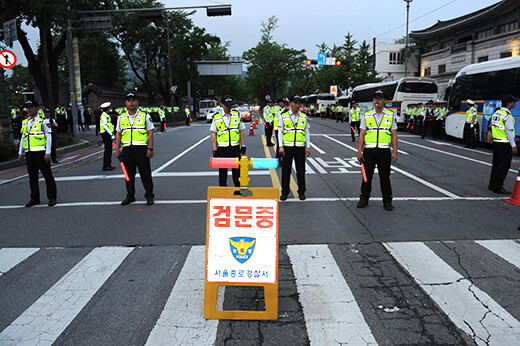hankyoreh
Links to other country sites 다른 나라 사이트 링크
Peaceful protests put down by Pres. Park’s ‘battering ram’

By Lee Moon-young, Hankyoreh 21 staff reporter
① 6,400 vs. 100 On June 10, a gathering of roughly 100 people around the Blue House demanding an inquiry into the Sewol ferry sinking was put down by 64 times as many police officers, with 69 arrests. Three to four people were “pinned down” by a group of about 200 police, and roads and alleys around the Blue House were sealed off tightly. Police also stopped taxis and boarded buses to inspect passengers. The day before, advance notices for 61 pre-registered demonstrations around the Blue House were rejected.
The images are symbolic of a larger trend. That same day, the first trial with the captain and crew of the Sewol was held at Gwangju District Court. It was the latest geographic shift in ground zero for the popular response to the sinking, which has moved from Jindo Gymnasium and Paengmok Port in South Jeolla Province to Ansan, Gyeonggi Province, then on to the offices of the KBS network, the Blue House, and the National Assembly before reaching the small Gwangju courtroom. A month before (on May 9), family members of Sewol victims paid a protest visit to the Blue House. This time, access there was strictly forbidden.

On June 11, around 2,000 police and 200 city employees were dispatched in Miryang, South Gyeongsang Province, against a group of 200 people - mostly elderly residents, along with others who had come to support them - fighting to stop the construction of electricity transmission towers. Screaming senior citizens were dragged off by a contingent of police ten times bigger than theirs. The Korea Electric Power Corporation (KEPCO) and the administration had been weighing the timing of their announcement because of the Sewol tragedy, but within a day of the trial’s start, all the remaining protest tents had been cleared away.

A martial law order for one man? On June 10, President Park Geun-hye blasted authorities for failing to capture former Semo Group chairman Yoo Byung-eun, believed to be the owner of the Sewol, saying it “is incredible that he hasn’t been caught yet”. Various government agencies responded with everything they had. Some even discussed sending in military troops as a precaution against attempts to smuggle Yoo out. Six thousand police officers were sent to the Kumsuwon compound in Anseong, Gyeonggi Province, headquarters of the Evangelical Baptist Church, to arrest two middle-aged members close to Yoo. The 100 members of the church who were guarding the front gate put up little resistance when confronted with sixty times as many police. But the arrest operation, for which helicopters and water cannons were mobilized, was unsuccessful, wasting a 3,000-to-one firepower advantage.
After the failed capture operation, the National Police Agency expanded the size of its arrest team from 150 members to 2,455 on June 13. Police officers also attended neighborhood meetings on Yoo’s arrest held in 480,000 small communities nationwide at the Ministry of Security and Public Administration’s request.
With Park pinning her fate on a war with Yoo, his alleged responsibility for the Sewol sinking is expected to grow.

All together, a total of 14,600 police were mobilized on June 10 and 11, the days after the hurdle of the first post-Sewol elections had been cleared. On the other side were 400 people - a ratio of 36 to one. It’s unclear whether this overwhelming force is due to overzealousness or ineptitude.
Meanwhile, the nomination of right-wing former Joong-Ang Ilbo editor-in-chief Moon Chang-keuk as Prime Minister is bringing back other memories of police suppressions. In a column on Feb. 3, 2009, Moon called for “saving [former Seoul Metropolitan Police Agency] commissioner Kim Seok-ki” after a police suppression of demolition protesters resulted in six dead in Seoul’s Yongsan district. His words suggest that he believes the harsh tactics used there are the definition of law and order.
The tears shed by President Park in a May 19 address to the nation on the Sewol tragedy may have helped her Saenuri Party to avoid a disaster in the June 4 municipal elections, but now that the elections are over, there are no more tears from the President. Instead, it’s the same politics of power, where she escapes her problems by forcibly putting down dissenting opinions. It’s happening once again, as she has resorted to past methods as a quick way out of her Sewol woes. The battering ram Park is back.
Please direct questions or comments to [english@hani.co.kr]

Editorial・opinion
![[Column] Is Korean democracy really regressing? [Column] Is Korean democracy really regressing?](https://flexible.img.hani.co.kr/flexible/normal/500/300/imgdb/original/2024/0705/2917201664129137.jpg) [Column] Is Korean democracy really regressing?
[Column] Is Korean democracy really regressing?![[Column] How tragedy pervades weak links in Korean labor [Column] How tragedy pervades weak links in Korean labor](https://flexible.img.hani.co.kr/flexible/normal/500/300/imgdb/original/2024/0703/8717199957128458.jpg) [Column] How tragedy pervades weak links in Korean labor
[Column] How tragedy pervades weak links in Korean labor- [Column] How opposing war became a far-right policy
- [Editorial] Korea needs to adjust diplomatic course in preparation for a Trump comeback
- [Editorial] Silence won’t save Yoon
- [Column] The miscalculations that started the Korean War mustn’t be repeated
- [Correspondent’s column] China-Europe relations tested once more by EV war
- [Correspondent’s column] Who really created the new ‘axis of evil’?
- [Editorial] Exploiting foreign domestic workers won’t solve Korea’s birth rate problem
- [Column] Kim and Putin’s new world order
Most viewed articles
- 110 days of torture: Korean mental patient’s restraints only removed after death
- 2Months after outcry over “torture devices,” Justice Ministry proposes more restraints for immigratio
- 3Beleaguered economy could stymie Japan’s efforts to buoy the yen
- 4[Column] Is Korean democracy really regressing?
- 5Koreans are getting taller, but half of Korean men are now considered obese
- 6[Column] How tragedy pervades weak links in Korean labor
- 7Former bodyguard’s dark tale of marriage to Samsung royalty
- 8Real-life heroes of “A Taxi Driver” pass away without having reunited
- 9[Editorial] Exploiting foreign domestic workers won’t solve Korea’s birth rate problem
- 10Democrats ride wave of 1M signature petition for Yoon to be impeached